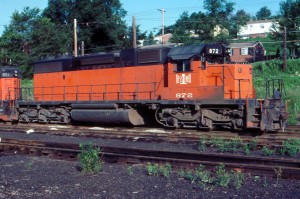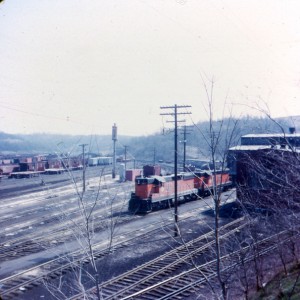
Track Plans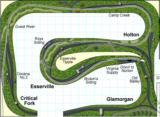 B&LE Track Plans B&LE Track Plans |
Photos | Models
(No B&LE models at this time) |
History
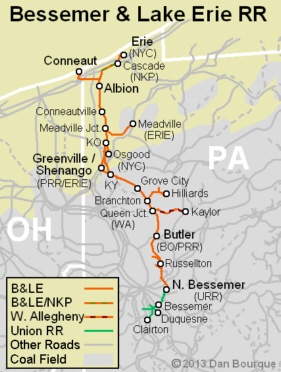 The earliest ancestor of the Bessemer and Lake Erie Railroad was the Bear Creek Railroad Company which began operations with 20 miles of track between its yard in Shenango, PA and coal mines near present-day Grove City in 1869. It was renamed the Shenango and Allegheny Railroad and the plan was to connect to the Atlantic and Great Western Railway. The railroad expanded south into the coalfields as new mines and oil fields opened, and a connection with the B&O at Butler, PA was made in 1883 through the West Penn and Shenango Railroad. The line went into receivership and was reorganized as the Pittburgh, Shenango and Lake Erie.
The earliest ancestor of the Bessemer and Lake Erie Railroad was the Bear Creek Railroad Company which began operations with 20 miles of track between its yard in Shenango, PA and coal mines near present-day Grove City in 1869. It was renamed the Shenango and Allegheny Railroad and the plan was to connect to the Atlantic and Great Western Railway. The railroad expanded south into the coalfields as new mines and oil fields opened, and a connection with the B&O at Butler, PA was made in 1883 through the West Penn and Shenango Railroad. The line went into receivership and was reorganized as the Pittburgh, Shenango and Lake Erie.
The PS&LE’s aim was to extend the line from Greenville to Lake Erie, and it did this by consolidating with the Erie, Shenango and Pittsburgh Railway which had acquired the right-of-way of the abandoned Erie Extension Canal which ran from Greenville, PA to Erie County. The North-Eastern Ohio railroad was organized to run from the port at Conneat, OH to a connection with this new railroad near Albion, PA, and the two roads were consolidated as the PS&LE in 1888. In 1891, the PS&LE gained trackage rights over the Nickel Plate Road to reach Erie, PA (these trackage rights are still in effect today), home to the Erie Terminal Railroad formed and leased by the PS&LE. A similar arrangement was made by forming and leasing the Conneaut Terminal Railroad Company in Ohio, and both were consolidated into the PS&LE in 1893.
With the addition of the West Penn and Shenango Railroad to the south, the PS&LE finished linking the railroad from Conneaut to Butler in 1892, but it had its sights set on reaching the booming industries of Pittsburgh and providing the best direct north-south avenue for traffic between the industries and Lake Erie. The PS&LE did not have the finances to complete a line to Pittsburgh, but Andrew Carnegie did. Carnegie was looking for a way to exert more control over his supply lines by connecting his steel mills in Pittsburgh to the ports at Lake Erie via railroad, and the PS&LE was the answer. Carnegie financed the Butler and Pittsburgh Railroad Company to connect his Union Railroad serving the steel mills in East Pittsburgh to the PS&LE at Butler. Consruction included the bridging of the Allegheny River with a 3,438 foot steel bridge. The PS&LE and Butler and Pittsburgh were merged into the Pittsburgh, Bessemer and Lake Erie Railroad under Carnegie’s control in 1897 before the line was even completed, and in 1900, a new company, controlled by Carnegie Steel, was formed to lease and run the railroad for 999 years–the Bessemer and Lake Erie Railroad.
Control of the Bessemer passed to US Steel with the buyout of Carnegie Steel, an ownership that lasted until 1988. With the expansion of the dock facilities at Conneaut, a traffic stream of ore (shipped in from Michigan via the Great Lakes) flowed south, and a stream of coal flowed north to be loaded onto ships–not just Bessemer coal but coal from the connecting railroads as well. Of course, other large industries grew up along the line including limestone processing (Branchton) and rail car manufacturing (Butler and Greenville). In 1902, the Bessemer completed teh Kremis-Osgood cutoff (K-O line) which greatly reduced the grades and curvature of the original Shenango line. The original mainline was retained as Shenango remained a major interchange point and Greenville remained the Bessemer’s headquarters and the location for their major shops and engine servicing facilities.
The Bessemer acquired its first diesel in 1936 and diesels completely replaced the Bessemer’s steamers including the famous 2-10-4 Texas types in 1953. The original diesel fleet consisted primarily of EMD F-units with a handful of SD7s, Baldwin road switchers and Alco switchers. In the ’60s, the Bessemer began to standardize on low-horsepower, 6-axle units which became a trademark of the Bessemer and its sister US Steel roads the Elgin, Joliet and Eastern and the Duluth, Missabe and Iron Range. These units included SD9s, SD18s and SD38s in the ’60s and was expanded to include SD38ACs and SD38-2s in the ’70s. The F-units and SD7s were relegated to switching and branch-line duties. The highest horsepower units on the road were a handful of 2400 hp Alco RSD-15s obtained in 1964 and sold in 1973.The 1750-2000 hp 6-axles were the standard mainline power until the addition of rebuilt SD45T-2s (3000 hp SD40-3s) in 1999.
The Bessemer made a few modest expansions in the diesel era. In addition to the construction and acquisition of a few industrial spurs in the ’50s, in 1967, the B&LE purchased the remaining 19 miles of the coal-hauling Western Allegheny railroad from the Pennsylvania RR–this line became the Western Allegheny Division of the B&LE. Interestingly, the B&LE had initially operated the WA from 1903-1908. Also in 1967, the B&LE took over operations of the 3.9-mile Unity Railways near North Bessemer which served the large Renton Mine.
In 1988, the B&LE became a part of Transtar Inc. along with other transportation-related pieces of US Steel. By this time, the B&LE had lost its Class I status, but the railroad’s purpose of shipping ore and coal changed little. In 2001, the Bessemer again changed hands to Great Lakes Shipping and in 2004 was purchased by Canadian National Railways. As of the time of this writing in 2013, the B&LE still maintains its unique identity.
Coal Lines and Operations
Coal was abundant on the south end of the B&LE. In the heyday of the steam era, there was a concentraion of tipples near Russelton, but tipples dotted the mainline from Russelton to Grove City. The Hilliards branch was also home to a handful of coal tipples. Despite its proximity to the steel mills of Pittsburgh, most of the B&LE’s coal headed north to Conneaut and Lake Erie because it wasn’t of sufficient quality for the mills. To maximize revenue miles, B&LE coal hoppers often returned south half-loaded with iron ore for the steel mills (half-loaded by bulk but fully loaded by weight; the B&LE also used smaller ore hoppers). Anything bound for the US Steel mills was handed off to the Union Railroad at North Bessemer as the Union’s tracks and curves proved unsuitable for the B&LE’s 6-axles. The B&LE also hauled a lot of coal brought in from its many connections. Coal for the steel mills could come from the B&LE or any of the Union Railroad’s many connections around east Pittsburgh. Most of the coal interchanged to the B&LE was bound for Conneaut.
Branchton Mine Crew. Until the ’80s, the Hilliards Branch was served by the Branchton Mine Crew crew based at Branchton, the B&LE main’s junction with the Hilliards Branch. This crew served not only the branch but several industries and loaders on the mainline between Filer (near Grove City) and Butler. In addition to coal, industries included a large limestone processing plant at Branchton and a limestone quarry on the Hilliards Branch (closed in 1958). The crew used the 400-car yard at Branchton to pick up empties and set out loads for mainline trains. Photos in the early ’80s show a single, non-dynamic SD7 as motive power. After the Branchton Mine Crew job was discontinued, this area was worked by a mine run out of Calvin Yard near Butler.
Western Allegheny. The most interesting coal operations were on the Western Allegheny. When the B&LE first purchased the WA in 1967, a single SW8 was all that was needed to work the meager coal traffic on the branch. With the onset of the coal boom in the ’70s and the opening/re-opening of several truck-dump style tipples on the branch, the B&LE replaced the switcher with F-units which performed better on the line’s tight curves than the SDs. Mine crews for the WA worked out of the small engine terminal at Kaylor near the end of the line. The grungy Fs would typically leave Kaylor in the late afternoon and gather loads from several tipples on its way to Queen Jct. At the junction, the mine crew would set off the loads and replace them with empties left by mainline trains. The crew would then work its way back up the branch, dropping empties at all the tipples along the way. The B&LE often worked with F units at both ends of the train, and it wasn’t unusual for one set of locos to work one tipple while the other set worked a different tipple. The dual-ended power also helped with the steep grades on the line–loads from the Kaylor area had to make their way up a 2.5% grade before they could coast downgrade to Queen Jct. The F units finally left the branch in 1992 and were replaced by SDs out of Butler until the line was abandoned in the late ’90s.
Unity Railways. Unity Railways was built to serve the large mine at Renton, PA, east of North Bessemer. The mine was idled in 1962, and the Unity Railways sold its switcher in 1965. When the mine re-opened in 1967, the B&LE served the 3.9-mile branch and tipple with a mine crew out of North Bessemer.
Mainline Coal Operations. The Branchton mine crew served the loaders on the mainline north of Butler, but there were loaders on the main between Butler and North Bessemer including the Russelton No 2 mine and coal-washing facility. This was a loads-in/loads-out operation and was served by a North Bessemer Mine Crew which also served the large sintering plant (turning fine ore into pellets usable in steel making) at Saxonburg. A modern loader was also installed at Newfield just north of North Bessmer in 1965.
Most of the B&LE mainline has grades less than 1%, but the profile is a roller coaster. Since loads move both north and south, helpers are commonplace in many places on the Bessemer. Even the line from Conneaut, the lowest portion of the B&LE, requires helpers to push ore and limestone trains up the “hogback” just south of the Conneaut yard. During the heyday of the diesel era, mainline crews worked out of Albion, Greenville, Calvin Yard (Butler), and North Bessemer (until 1983). Coal bound primarily for Conneaut was picked up from loaders along the line, but even more coal was picked up from the B&LE’s connections with the Pennsylvania (and later PC, Conrail and Pittsburgh & Lake Erie via trackage rights over Conrail from Youngstown, OH to Shenango) and B&O (later Buffalo & Pittsburgh) among others. The Union Railroad brought even more coal to the B&LE through coal received via barge at Duquesne wharf along with the Union’s connections with PRR, B&O, P&LE, and the N&W’s former Pittsburgh & West Virginia line. These connections would later become the Conrail, CSX, NS and Wheeling & Lake Erie.
Motive Power
The B&LE’s orange and black diesel fleet was unique among Appalachian coal hauling railroads because it relied primarily on 6-axles with low horsepower as mentioned earlier. In the ’70s, the Bessemer owned pretty much every EMD non-turbocharged 6-axle model offered including SD7s, SD9s (both high- and low-nose), SD18s, SD38s, SD38ACs and SD38-2s. The fleet was a mix of new builds and second-hand acquisitions from other railroads, most notably corporate partner Duluth, Missabe & Iron Range. F-units worked the WA and the docks at Conneaut until retired in the early ’90s. In 1999-2000, the B&LE modernized its fleet somewhat with rebuilt ex-Southern Pacific SD45T-2s which have been repowered and derated from 3600 to 3000 hp and designated as SD40T-3Ms. Ironic that a railroad with no mainline tunnels is powered by tunnel motors.
Bessemer and Lake Erie Diesel Roster
| Number | Builder | Model | HP | Notes |
| 150-153 | EMD | SW1500 | 1500 | ex-PC/CR, acq mid ’90s |
| 160-161 | EMD | SW1500 | 1500 | ex-URR, acq mid ’90s |
| 210 | EMD | SD38-2 | 2000 | ex-DM&IR, acq 1980* |
| 281 | Westinghouse | 65-ton | 530 | New 1936 |
| 282 | Baldwin | DS-4-4-10 | 1000 | New 1949 |
| 285 | EMD | SW8 | 800 | ex-DSO, acq 1963 |
| 286 | EMD | NW2 | 1000 | ex-LT, NB, acq 1973 |
| 291-292 | Alco | S-4 | 1000 | New 1952 |
| 401-407 | Baldwin | DRS-6-6-15 | 1500 | New 1949-1950 |
| 701A-728A | EMD | F7A | 1500 | New 1950-1953 |
| 701B-726B | EMD | F7B | 1500 | New 1950-1953 |
| 451-455 | EMD | SD7 | 1500 | New 1953 |
| 658 | EMD | SD38-2 | 2000 | ex-EJ&E, acq 1980* |
| 801-803 | EMD | SD7 | 1500 | New 1952 |
| 821-847 | EMD | SD9 | 1750 | ex-DM&IR, acq 1964-1977 |
| 851-857 | EMD | SD18 | 1800 | New 1962 |
| 858-859 | EMD | SD18 | 1800 | ex-DM&IR SD-M, acq 1998 |
| 861-863 | EMD | SD38 | 2000 | New 1967 |
| 864-869 | EMD | SD38AC | 2000 | New 1971 |
| 870-879 | EMD | SD38-2 | 2000 | New 1973-1974 |
| 881-886 | Alco | RSD-15 | 2400 | ex-DM&IR, acq 1964 |
| 890-892 | EMD | SD38-2 | 2000 | New 1975-1976* |
| 900-910 | EMD | SD40T-3M | 3000 | Rebuilt from SP SD45T-2s, acq 1999-2000 |
*BL&E SD38-2s 891-892 traded for DM&IR SD38-2 210 and EJ&E SD38-2 658 in 1980
Related Products:
Sources:
- Lorenzo, R. and Clark, N. Bessemer and Lake Erie Railroad In Color, Morning Sun Books 1994
- Bever, R. The Bessemer and Lake Erie Railroad 1869-1969, Golden West Books 1969
- Trains.com B&LE SD40-T3M roster





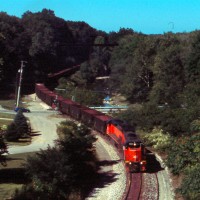 B&LE Photos
B&LE Photos